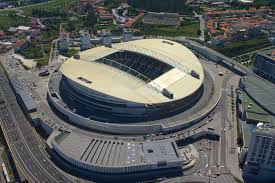Introduction to Estádio do Dragão
Welcome to the heart of Porto, where passion and pride come alive in every match. The Estádio do Dragão is not just a stadium; it’s a symbol of resilience, community, and sporting excellence. Home to FC Porto, this architectural marvel has seen countless unforgettable moments etched into its history. With its striking design and vibrant atmosphere, the stadium draws fans from all corners of the globe. Whether you’re an avid football supporter or simply curious about one of Europe’s most iconic venues, join us as we dive into what makes Estádio do Dragão truly special.
History and Construction of the Stadium
Estádio do Dragão opened its doors in 2003, becoming the home of FC Porto. It was built to replace the older Estádio das Antas, which had served the club for decades.
The stadium features a striking modern design by architect Manuel Salgado. The construction process began in 2001 and took just two years to complete. This ambitious project aimed not only to enhance spectator experience but also to elevate Porto’s status on the international stage.
With a capacity of over 50,000 seats, it combines functionality with aesthetic appeal. Every detail reflects both tradition and innovation, making it an emblematic structure in Portugal’s architectural landscape.
Since its inception, Estádio do Dragão has hosted numerous high-profile events beyond football. Its versatility continues to attract concerts and cultural gatherings, solidifying its role as a key venue in Porto’s vibrant community life.
Unique Features and Design
Estádio do Dragão stands out with its striking architecture. The exterior is a seamless blend of glass and steel, reflecting the modern spirit of Porto. Its bold design captures attention from afar.
Inside, the stadium can seat over 50,000 fans. The layout ensures that every spectator has an unobstructed view of the pitch. This commitment to visibility enhances the atmosphere during matches.
The iconic blue and white colors pay homage to FC Porto’s heritage. Unique mosaics adorn various sections, celebrating the club’s rich history and achievements.
Another fascinating aspect is its roof structure. It not only provides shelter but also amplifies sound, creating an electric environment on game days.
With facilities designed for both comfort and accessibility, Estádio do Dragão invites everyone to experience exhilarating football moments in style.
Notable Matches and Events Held at Estádio do Dragão
Estádio do Dragão has been the stage for countless memorable moments in football history. Since its opening, it has hosted intense matches that captivate fans worldwide.
One of the standout events was the UEFA Champions League match where FC Porto triumphed over AS Monaco in 2004. The victory secured Porto’s place among European elites and solidified their reputation on a grand scale.
In addition to club fixtures, Estádio do Dragão also welcomed international competitions. It served as one of the venues during Euro 2004, showcasing thrilling games that brought nations together.
Beyond football, this stadium has embraced diverse events. Concerts featuring renowned artists have echoed within its walls, creating a vibrant atmosphere that extends beyond sports.
Each match and event at Estádio do Dragão contributes to an ever-growing legacy that resonates with every visitor who steps inside its iconic architecture.
Behind the Scenes: Touring the Stadium
Stepping into Estádio do Dragão is like entering a world of passion and history. A guided tour reveals the inner workings of this iconic venue. Visitors can explore the players’ tunnel, feeling the adrenaline that surges before each match.
The locker rooms are a treasure trove of stories. Each corner whispers tales of legendary athletes preparing for battle on the pitch. As you walk through, it’s easy to imagine the intensity and camaraderie shared within these walls.
Beyond just football, the stadium boasts impressive facilities. The press room showcases how media coverage brings events to life for fans around the globe.
Don’t miss out on visiting the trophy room. It gleams with silverware, showcasing FC Porto’s storied achievements over decades.
Every step in this hallowed ground immerses visitors deeper into its legacy, making it much more than just a stadium; it’s an experience steeped in culture and pride.
The Impact of Estádio do Dragão on the Local Community
Estádio do Dragão is more than just a football stadium. It serves as a hub for community engagement in Porto. Locals come together to cheer on their beloved FC Porto, fostering a sense of unity.
The stadium has boosted local businesses too. Restaurants and shops nearby thrive during match days, creating jobs and enhancing the economy. Visitors flock to experience the vibrant atmosphere that surrounds each event.
Moreover, Estádio do Dragão hosts cultural events beyond football. Concerts and exhibitions draw diverse crowds, enriching the city’s cultural landscape. This multifunctional use transforms it into a gathering place for all residents.
Youth programs associated with the stadium encourage sports participation among young people in Porto. By nurturing talent and promoting healthy lifestyles, it leaves an enduring legacy on future generations. The impact reaches far beyond its walls; it’s woven into the fabric of community life.
Also check: Estádio Municipal de Braga (Estádio AXA) stadium
Conclusion
Estádio do Dragão stands as a monumental symbol of Porto’s rich football culture. Its impressive architecture and state-of-the-art facilities make it more than just a place for matches; it’s a hub for community events, celebrations, and unforgettable memories.
The stadium has shaped the local landscape both socially and economically. It draws visitors from around the world, contributing to tourism in the area while also providing jobs and opportunities for local businesses.
Whether you’re a die-hard football fan or simply someone who appreciates architectural beauty, Estádio do Dragão offers something special. From its thrilling game days to serene moments during off-peak hours, this stadium truly embodies the spirit of Porto. A visit here promises not only an engaging experience but also insight into what makes this city so vibrant and unique.
